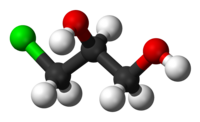3-MCPD
 |
|
 |
|
| Names | |
|---|---|
|
IUPAC name
3-Chloropropane-1,2-diol
|
|
| Other names
3-Monochloropropane-1,2-diol; α-Chlorohydrin; Glycerol α-monochlorohydrin; Chlorodeoxyglycerol; 3-Chloro-1,2-propanediol
|
|
| Identifiers | |
|
3D model (Jmol)
|
|
| ChEBI | |
| ChemSpider | |
| ECHA InfoCard | 100.002.267 |
| EC Number | 202-492-4 |
| KEGG | |
|
PubChem CID
|
|
|
|
|
|
| Properties | |
| C3H7ClO2 | |
| Molar mass | 110.54 g·mol−1 |
| Appearance | Viscous, colorless liquid |
| Density | 1.32 g·cm−3 |
| Melting point | −40 °C (−40 °F; 233 K) |
| Boiling point | 213 °C (415 °F; 486 K) |
| Hazards | |
| Safety data sheet | External MSDS |
| R-phrases (outdated) | R26/27/28-R36/37/38 |
| S-phrases (outdated) | S24-S45 |
|
Except where otherwise noted, data are given for materials in their standard state (at 25 °C [77 °F], 100 kPa).
|
|
|
|
|
| Infobox references | |
3-MCPD (3-monochloropropane-1,2-diol or 3-chloropropane-1,2-diol) is an organic chemical compound which is carcinogenic and highly suspected to be genotoxic in humans, has male anti-fertility effects, and is a chemical byproduct which may be formed in foods, the most commonly found member of chemical contaminants known as chloropropanols.
It is primarily created in foods by protein hydrolysis by adding hydrochloric acid at high temperature to speed up the breakdown of proteins into amino acids. Under these conditions, chloride can react with the glycerol backbone of lipids to produce 3-MCPD. 3-MCPD can also occur in foods which have been in contact with materials containing epichlorohydrin-based wet-strength resins which are used in the production of some tea bags and sausage casings.
It has been found in some East Asian and Southeast Asian sauces such as oyster sauce, Hoisin sauce and soy sauce. Using hydrochloric acid rather than traditional slow fermentation is a far cheaper and faster method but unavoidably creates chloropropanols. A 2013 European Food Safety Authority report indicated margarine, vegetable oils (excluding walnut oil), preserved meats, bread, and fine bakery wares as major sources in Europe.
3-MCPD is carcinogenic in rodents via a supposed non-genotoxic mechanism. It is able to cross the blood-testis barrier and blood–brain barrier. The oral LD50 of 3-chloro-1,2-propanediol is 152 mg/kg bodyweight in rats.
...
Wikipedia
